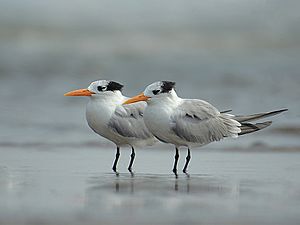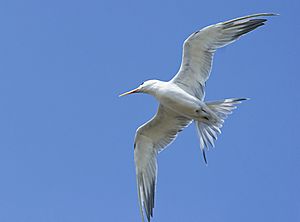Lesser crested tern facts for kids
Quick facts for kids Lesser crested tern |
|
|---|---|
 |
|
| A pair of Lesser crested terns Thalasseus bengalensis from Akshi Beach, Maharashtra, India | |
| Conservation status | |
| Scientific classification | |
| Genus: |
Thalasseus
|
| Species: |
bengalensis
|
| Synonyms | |
|
Sterna bengalensis Lesson, 1831 |
|
The lesser crested tern (Thalasseus bengalensis) is a type of tern. Terns are a group of sea birds that belong to the Laridae family. These birds are known for their graceful flight and their skill at catching fish.
Contents
What's in a Name?
The name Thalasseus comes from Ancient Greek. It means "fisherman" and comes from the word thalassa, which means "sea". This makes sense because these birds are great at fishing!
The second part of its name, bengalensis, means "from Bengal". Bengal is a region that historically covered a large part of northern India and Bangladesh. This is where the first bird of this type was officially described.
Where Do They Live?
Lesser crested terns live in warm coastal areas around the world. They breed, or have their babies, mainly from the Red Sea across the Indian Ocean to the western Pacific Ocean. You can also find them in Australia.
A large group of these birds lives on two islands off the coast of Libya in the southern Mediterranean Sea. Sometimes, they have even been seen breeding by accident in Italy and France.
Birds in Australia usually stay in one place. However, other groups of lesser crested terns are migratory. This means they travel long distances. They spend their winters in places as far south as South Africa.
Different Kinds of Lesser Crested Terns
This bird has a few different types, called subspecies. These subspecies are found in different places. They mostly differ in their size and small details of their feathers.
- T. b. emigrata: These terns breed in the Mediterranean Sea near Libya. They spend their winters in West Africa. They are a pale grey color on top and are a bit larger.
- T. b. bengalensis: This type lives in the northern Indian Ocean. They fly to South Africa for the winter. They are a medium-dark grey on top and are a bit smaller.
- T. b. torresii: You can find these terns from Indonesia south to Queensland, Australia. They also spend their winters in the same area. They are dark grey on top and are a bit larger.
The Mediterranean type of tern is rarely seen in Europe. However, they have bred there, sometimes with Sandwich terns, in countries like Italy, Spain, and England.
Reproduction and Life Cycle
Lesser crested terns build their nests in large groups called colonies. They usually choose coasts and islands for their nesting sites. They make a simple nest on the ground, which is just a small scrape. In this nest, they lay one to two eggs, but sometimes they might lay three.
Their nesting habits are very similar to those of Sandwich terns. They nest in very crowded colonies to help protect themselves from predators. Predators are animals that hunt other animals for food. For example, the emigrata subspecies nests in late summer. By this time, predatory yellow-legged gulls have finished breeding and left the nesting area. This helps keep the terns' eggs and chicks safe.
What Do They Look Like?
Lesser crested terns are medium-sized birds. They look very much like their close relatives, such as the Sandwich tern and Elegant tern.
In summer, adult birds have a black cap on their head. They have black legs and a long, sharp orange beak. Their upper wings, rump (the lower back), and middle tail feathers are grey. Their belly and chest are white. As summer goes on, their main flight feathers become darker. In winter, the front part of their head turns white. Their call sounds like a loud, harsh grating noise, similar to the Sandwich tern.
A good way to tell them apart when they are flying is their grey rump. Other similar terns have different features. For example, the Elegant tern has a slightly longer, thinner beak. The Chinese crested tern has a black tip on its beak. The Sandwich tern has a black beak with a yellow tip.
Young lesser crested terns look like young Sandwich terns. However, they have a yellow-orange beak. They are also paler overall, with only faint dark marks on their back feathers.
There are two other terns with orange beaks in the same areas as the lesser crested tern: the royal tern and the Greater crested tern. Both of these are much larger and have thicker beaks. The royal tern also has a white rump and tail. The crested tern, which does have a grey rump, is darker overall and has a more yellowish beak.
Protecting These Birds
The lesser crested tern is a species that is part of an important agreement. This agreement is called the Agreement on the Conservation of African-Eurasian Migratory Waterbirds (AEWA). This means there are efforts to protect these birds as they travel between Africa and Eurasia.
It is also one of 10 sea bird species listed in the Mediterranean marine birds Action Plan. This plan aims to protect sea birds in the Mediterranean Sea.
In India, the Lesser crested tern is protected in a special place called the PM Sayeed Marine Birds Conservation Reserve. This reserve helps keep their habitats safe.
Images for kids
See also
 In Spanish: Charrán bengalí para niños
In Spanish: Charrán bengalí para niños






